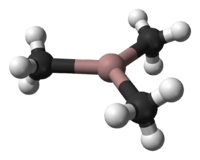Trimethylgallium
 | |
 | |
| Names | |
|---|---|
| IUPAC name
trimethylgallane, trimethanidogallium | |
| Identifiers | |
| 1445-79-0 | |
| 3D model (Jmol) | Interactive image |
| ChemSpider | 14323 |
| ECHA InfoCard | 100.014.452 |
| PubChem | 15051 |
| |
| |
| Properties | |
| Ga(CH3)3 | |
| Molar mass | 114.827 g/mol |
| Appearance | clear colourless liquid |
| Melting point | −15 °C (5 °F; 258 K) |
| Boiling point | 55.7 °C (132.3 °F; 328.8 K) |
| Hazards | |
| Main hazards | pyrophoric |
| Except where otherwise noted, data are given for materials in their standard state (at 25 °C [77 °F], 100 kPa). | |
| | |
| Infobox references | |
Trimethylgallium, Ga(CH3)3, often abbreviated to TMG or TMGa, is the preferred metalorganic source of gallium for metalorganic vapour phase epitaxy (MOVPE) of gallium-containing compound semiconductors, such as GaAs, GaN, GaP, GaSb, InGaAs, InGaN, AlGaInP, InGaP and AlInGaNP.
Properties
TMG is a clear, colorless, pyrophoric liquid.[1] Even the hydrocarbon solutions of TMG, when sufficiently saturated, are known to catch fire on exposure to air. TMG is known to react violently with water and other compounds that are capable of providing labile and active hydrogen (i.e. protons). Therefore, TMG needs to be handled with care and caution, e.g. stored in a cool, dry place at 0-25 °C, under inert atmosphere, and ensuring that storage temperatures would not exceed 40 °C to avoid deterioration.
Preparation
Trimethylgallium may be prepared by the reaction of dimethylzinc with gallium trichloride. The less volatile diethyl ether adduct can be prepared by using methylmagnesium iodide in ether in place of dimethylzinc; the ether ligands may be displaced with liquid ammonia as well.[2]
Applications
The material is used in the production of LED lighting and semiconductors as a metalorganic chemical vapor deposition precursor.
References
- ↑ Shenai-Khatkhate, D. V.; Goyette, R. J.; Dicarlo, R. L. Jr; Dripps, G. (2004). "Environment, health and safety issues for sources used in MOVPE growth of compound semiconductors". Journal of Crystal Growth. 272 (1–4): 816–21. Bibcode:2004JCrGr.272..816S. doi:10.1016/j.jcrysgro.2004.09.007.
- ↑ Kraus, C. A.; Toonder, F. E. (1933). "Trimethyl Gallium, Trimethyl Gallium Etherate and Trimethyl Gallium Ammine". PNAS. 19 (3): 292–8. Bibcode:1933PNAS...19..292K. doi:10.1073/pnas.19.3.292. PMC 1085965
 . PMID 16577510.
. PMID 16577510.